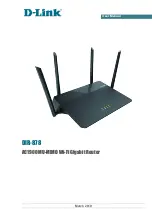
Chapter 1: Configuration
Configuring security
Page
1-120
Filtering management through Ethernet
See Filtering management through Ethernet in Installation and Planning Guide.
Allowing management only from specified IP addresses
See Allowing management only from specified IP address in Installation and Planning Guide.
Restricting radio Telnet access over the RF interface
RF Telnet Access restricts Telnet access to the AP from a device situated below a network SM
(downstream from the AP). This is a security enhancement to restrict RF-interface sourced AP access
specifically to the LAN1 IP address and LAN2 IP address (Radio Private Address, typically 192.168.101.
[LUID]). This restriction disallows unauthorized users from running Telnet commands on the AP that can
change AP configuration or modifying network-critical components such as routing and ARP tables.
The RF Telnet Access may be configured via the AP GUI or via SNMP commands, and RF Telnet Access
is set to “Enabled” by default. Once RF Telnet Access is set to “Disabled”, if there is a Telnet session
attempt to the AP originating from a device situated below the SM (or any downstream device), the
attempt is dropped. This also includes Telnet session attempts originated from the SM’s management
interface (if a user has initiated a Telnet session to a SM and attempts to Telnet from the SM to the AP).
In addition, if there are any active Telnet connections to the AP originating from a device situated below
the SM (or any downstream device), the connection is dropped. This behavior must be considered if
system administrators use Telnet downstream from an AP (from a registered SM) to modify system
parameters.
Setting RF Telnet Access to “Disabled” does not affect devices situated above the AP from accessing
the AP via Telnet, including servers running the CNUT (Canopy Network Updater tool) application. Also,
setting RF Telnet Access to “Disabled” does not affect any Telnet access into upstream devices
(situated above or adjacent to the AP) through the AP (see
Содержание PTP 450 Series
Страница 51: ...Chapter 1 Configuration Quick link setup Page 1 23...
Страница 155: ...Chapter 1 Configuration Configuring security Page 1 127...
Страница 160: ...Chapter 1 Configuration Configuring security Page 1 132 Table 41 Security attributes 450 Platform Family BHM...
Страница 163: ...Chapter 1 Configuration Configuring security Page 1 135...
Страница 164: ...Chapter 1 Configuration Configuring security Page 1 136...
Страница 169: ...Chapter 1 Configuration Configuring security Page 1 141 Table 43 Security attributes 450 Platform Family BHS...
Страница 193: ...Chapter 1 Configuration Configuring radio parameters Page 1 165...
Страница 194: ...Chapter 1 Configuration Configuring radio parameters Page 1 166...
Страница 195: ...Chapter 1 Configuration Configuring radio parameters Page 1 167...
Страница 206: ...Chapter 1 Configuration Configuring radio parameters Page 1 178...
Страница 210: ...Chapter 1 Configuration Configuring radio parameters Page 1 182...
Страница 232: ...Chapter 1 Configuration Configuring radio parameters Page 1 204 Figure 27 Multicast scheduler statistics...
Страница 305: ...Chapter 1 Configuration Configuring a RADIUS server Page 1 277 Table 89 Security tab attributes...
Страница 342: ...Chapter 1 Configuration Configuring a RADIUS server Page 1 314 6 Finally press Save Changes and you are ready to use it...
Страница 408: ...Chapter 3 Operation System information Page 3 8 Table 115 General Status page attributes PMP 450 AP...
Страница 423: ...Chapter 3 Operation System information Page 3 23 Site Contact Site Location Time Updated and Location Code...
Страница 636: ...Chapter 5 Troubleshooting Logs Page 5 16 Figure 95 SM Authorization log...
















































